|
|
|
|
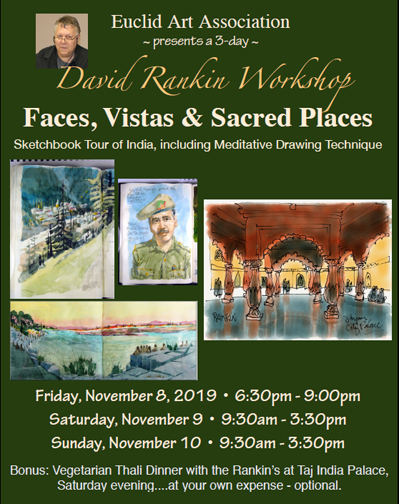 |
David Rankin
Watercolor Workshop
Faces, Vistas & Sacred Places:
Sketchbook Tour of India II,
plus Meditative Drawing Technique
Euclid Art Association
Friday,
November 8 - 10, 2019
|
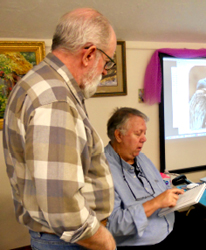 We
enjoyed an outstanding weekend workshop sketching India with
internationally acclaimed artist, David Rankin. David shared
his sketching techniques that he developed over 30 years traveling
throughout India. On Friday evening, while enjoying a cup of
chai tea and spicy samosas (provided by his lovely wife, Deanna),
we listened to David tell us the difference between a sketchbook
and artist journal. A sketchbook is a living, traveling
studio that travels with you. You can put anything into it,
like your thoughts, likes, things that catch your eye, etc.
A journal is different. It has a unique point of interest or
a specific goal and covers one subject or destination. You
take pictures and sketch later. As an example David
mentioned the Himalayan journal that he created for the Artists
for Conservation "Flag Expedition Grant" he was honored to receive
in 2007. It contains 300 small watercolors related to the
goal of that expedition. Take a look...click
here.
David said that in this workshop we would be drawing some very
challenging subjects....and he wasn’t kidding! He went on to
say, “you can’t make a mistake; it’s amazing what a little
watercolor does to your sketch.” When traveling, he
suggested taking your camera, Paynes gray, a couple of brushes,
pencils and your sketchbook. David likes the blue XL Mix
Media, 7” x 10”, 98 lb, by Canson, because of the weight of the
paper.
Our Sketchbook Tour began....we started sketching using a pencil.
We imagined that we were inside the airport terminal, looking out
the window at the plane that we would be traveling in....”now
sketch it and do it quickly.” David said that sketching
quickly is a very valuable skill to develop. He gave us 3 to
4 minutes to sketch the plane. This was a complex subject.
Where to start the sketch was the question from the class.
We knew from previous classes with David that you start sketching
a bird with its beak and for portrait of a person, with their hair
or hat. The answer, “start with what’s closest to you.”
We started with the tail of the plane. David reminded us of
his “stop, look, go” technique...more on that later.
Next, we sketched ‘Bob and Judy sleeping on the
plane’. We started with Bob and sketched the top of his head
or hair and attached the shape of the face to it; added the
pillow, placed the nostril and eyes. Repeat with Judy.
Breakfast at the Imperial Hotel was our next sketch...start with
shapes and add another shape, etc. David said that the skill
is to ‘do it’ quickly, using his ‘stop, look, go’ technique and
key is ‘don’t lift the pencil off the page.’ The next day we
added Paynes gray to our sketches after watching David
demonstrate. We also did several other fast sketches of an
auto rickshaw and birds with only a 15 second peak at the
reference. The objective was to improve our observation
skills. David said, “you need to tap into visual memory, so
that when you see something in a moment you can then sketch it
quickly.”
|
TIP: “Stop, Look, Go” technique - Start
sketching, stop but keep the pencil on the page,
look at the image and decide where to go next.
Don’t lift the pencil off the page. |
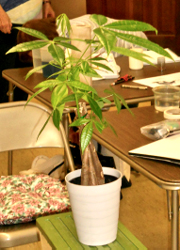 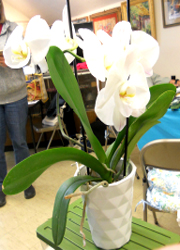 At
the start of the workshop on Saturday and Sunday morning, David
guided us through his Meditative Drawing technique to quiet
and center us. But first, he shared why he paints
India...how it all began. After art school in 1967, David
practiced yoga with his teacher, Alice Christensen and his guru,
Swami Rama of Haridwar, India. David made many trips to
India starting in 1970. In 1985, he had a vivid dream to
“paint India”. A Goddess came to him in his dream, startling
him and with clarity said, “Begin with my birds!”. His “Painted
Storks of India” was his first. David told us to pay
attention to our dreams and intuition. He went on to define
meditation as not a prayer...you are not asking God for anything.
“If for any reason God, in full form, appears in front of you,
don’t ask Him for anything. If you don’t ask, God may be
here to give you ‘more’.”
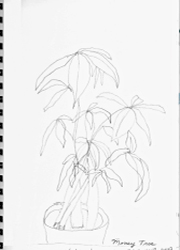 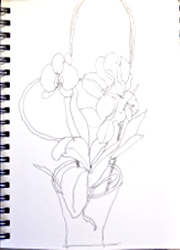 With
cell phones off, we positioned ourselves comfortably around a live
plant (‘Money Tree’ on Saturday and on Sunday an orchid)
that we were to draw. The concept of one-pointed focus in
yoga is called ekagrata (a state of calmness from a state of
evenness). And we began...for the next 10 to 15 minutes we
focused on drawing the plant. David said, “Start drawing at
the top of the plant closest to you and draw what you see.”
For the orchid, David instructed us to find the blossom nearest to
us and at the top. He went on to say “don’t draw through the
blossoms, but draw front and then back, draw the spatial
relationship.” Then, for the next 5 minutes we moved into a
yogic breathing pattern, breathing gently in & out. That was
followed by 10 minutes of stillness/silence. David said to
go inward and quiet your mind’s conversation. Relax the
voice in your mind and go into stillness. Some of us found
that very hard to do....right, Laurie? With
cell phones off, we positioned ourselves comfortably around a live
plant (‘Money Tree’ on Saturday and on Sunday an orchid)
that we were to draw. The concept of one-pointed focus in
yoga is called ekagrata (a state of calmness from a state of
evenness). And we began...for the next 10 to 15 minutes we
focused on drawing the plant. David said, “Start drawing at
the top of the plant closest to you and draw what you see.”
For the orchid, David instructed us to find the blossom nearest to
us and at the top. He went on to say “don’t draw through the
blossoms, but draw front and then back, draw the spatial
relationship.” Then, for the next 5 minutes we moved into a
yogic breathing pattern, breathing gently in & out. That was
followed by 10 minutes of stillness/silence. David said to
go inward and quiet your mind’s conversation. Relax the
voice in your mind and go into stillness. Some of us found
that very hard to do....right, Laurie?
Now for the more challenging subjects David promised. We
painted a camel with rider as a silhouette against an orange
sunset, the Amber Fort, which was more about the drawing than
perspective, and a two-page landscape scene of the back side to
the Taj. In complex subjects, ask “how would I paint this?”
Click these links for detailed examples of the
sketching/painting of the Camel, Amber Fort and Taj Mahal
Sketching:
Camel
Amber Fort
Taj Mahal
Painting:
Camel
Amber Fort
Taj Mahal
Here are tips that David gave us:
- Remember
to draw shapes. It’s not hard if done in pieces
(shapes).
|
- Draw with
a singular line, not 5 lines!
|
- Where are
the lightest, brightest, whitest parts of the painting?
|
- Where are
the darkest darks?
|
David was trying to eradicate our fear of
challenging subjects. David challenged us to avoid those
prejudged feelings of “I am not” or “I can’t”. And suggested
we change the statement to a supportive statement like, “How would
I paint or draw that?” David said that when he asked this
question, an answer came to him in a ‘different form’. He
went on to say your own intuition delivers guidance to you, but
you need to ask. Intuition is ‘female’...develop your
ability to hear her, let her tell you ‘what to do next?’ “Be
patient and coax your own creativity along.”
This was a great weekend workshop in so many ways....thank you,
David and Deanna, too.

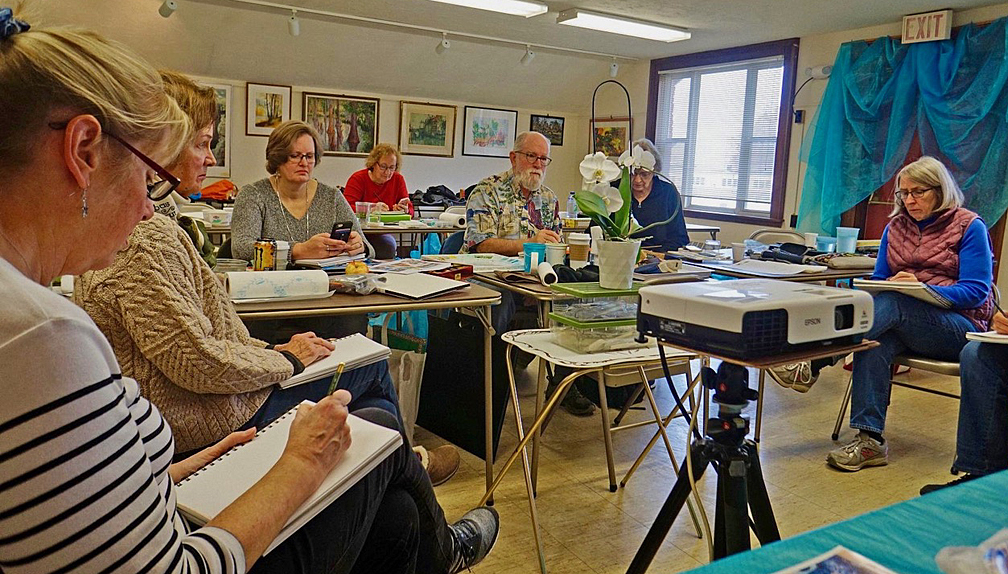
|
|
|